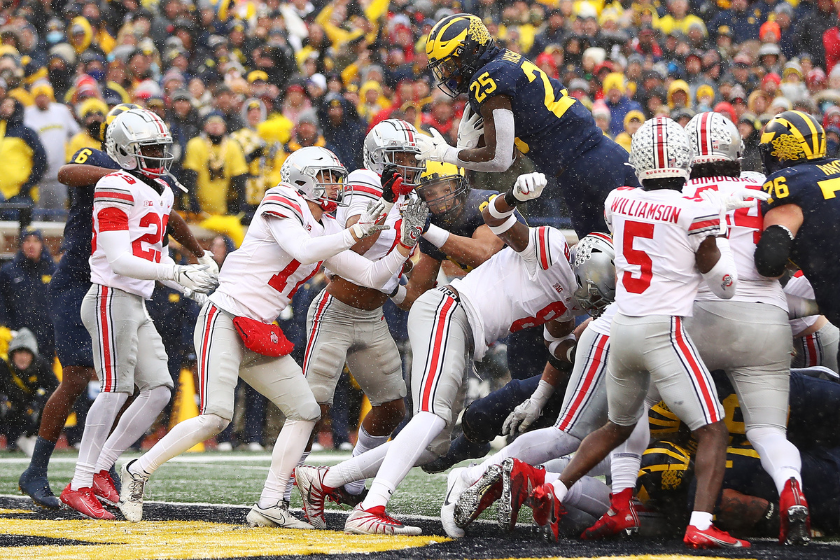The Bible says love thy neighbor, but I don't trust college football fans who don't hate thy neighbor. You see, the best college football rivalries stem from regionalism. We're talking Texas and Texas A&M, Minnesota and Wisconsin, Oklahoma and Oklahoma State, Ole Miss and Mississippi, Cal and Stanford, Auburn and Alabama and anyone Notre Dame plays in the continental United States.
It's about bragging rights and clowning your friend with a "better luck next year" text or 12-pack of Dos Equis (not sponsored content). However, some rivalries are rooted deeper than a simple football game.
Take the Ohio State and Michigan rivalry for instance. Their annual meeting is the result of a state feud that started 187 years ago.
The Toledo War: How Ohio State and Michigan Became Rivals
RELATED: Camp Randall Stadium's Haunted History Dates Back to the Civil War
Back in 1787, the U.S. government set aside 260,000 square miles of territory surrounding the Great Lakes to eventually divide into states in a piece of legislation called the Northwest Ordinance.
The law determined the border between Michigan and Ohio would be "an east and west line drawn through the southerly bend or extreme of Lake Michigan until it intersected Lake Erie." However, inaccurate maps at the time depicted Lake Michigan's southern border several miles north of where it actually was, thus placing the new town of Toledo—and the surrounding area called the Toledo Strip—in Ohio rather than Michigan.
Why was Toledo sought after? Well, it sat at the mouth of the Maumee River and Lake Erie, making it a valuable trade port. So, when the dispute was still unresolved upon the completion of the Erie Canal in 1825, it became a crucial link to the East Coast.
In an effort to strengthen their claim on the disputed territory, Michigan built infrastructure, collected taxes and held elections while Ohio officials blocked Michigan's petition for statehood to keep the land for themselves.
Then, in 1835, 23-year-old Michigan governor Stevens T. Mason—otherwise known as the "Boy Governor"—upped the ante by passing the "Pain and Penalties Act", which laid down harsh fines and jail sentences on Ohio officials who tried to exercise jurisdiction in the territory. In response, Ohio governor Robert Lucas passed legislation to extend his state's county borders into the disputed territory.
With tensions high, war looked imminent. Michigan officials followed the "Pain and Penalties" Act and arrested Ohio officials while dragging a burned Ohio state flag through the streets. Later that year, Michigan sheriff Joseph Wood set out to arrest an Ohio man named Two Stickney (great name) in a tavern, but all hell broke loose and Stickney pulled out a knife and fatally stabbed Wood.
The feud never grew into an all-out violent conflict (Wood was the only death), but it came close when Lucas held court in Toledo to retain his state's rights to the land. In response, Mason rounded up a militia of 1,200 men to prevent the meeting from happening by violence, if necessary. However, the Ohio folks tricked the Michigan men by holding the meeting at night and fled before the militia reached them.
At this point, President Andrew Jackson stepped in and removed Mason from his governorship. He was immediately voted back into office when he was eligible two years later, but tensions had cooled by then.

Mike Mulholland via Getty Images
The conflict reached its conclusion when Congress drew up a compromise that would give Michigan stateship at the cost of relinquishing their claim on the Toledo Strip. They were given what is now known as the Upper Peninsula as compensation. It was the official end of the petty war, but border disputes continued until 1915 when new state maps were made. To celebrate the "official official" end, the lieutenant governors of each state shook hands at the border of a peninsula on Lake Erie. The same event was recreated in 1965 to commence its 50th anniversary.
State borders are drawn in ink these days, but the deep-rooted hostility between Ohio and Michigan is still palpable on the football field. The rivalry, known as "The Game", started in 1897 when tensions were still high and has been played every year except 1898 and 1899. It's about as even as you can get, with the Wolverines leading the all-time series 59-51-6, but Ohio State had an eight year run until Michigan broke it with a 45-27 win last year.
It's safe to say there is no love lost between the Michigan Wolverines and Ohio State Buckeyes. And it all began over a little strip of land.

